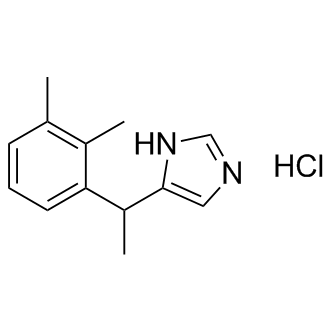
Medetomidine hydrochloride
CAS No. 86347-15-1
Medetomidine hydrochloride( MPV-785 )
Catalog No. M16251 CAS No. 86347-15-1
A potent, highly selective α2-adrenoceptor agonist with Ki of 1.08 nM; used as both a surgical anesthetic and analgesic.
Purity : >98% (HPLC)
 COA
COA
 Datasheet
Datasheet
 HNMR
HNMR
 HPLC
HPLC
 MSDS
MSDS
 Handing Instructions
Handing Instructions
| Size | Price / USD | Stock | Quantity |
| 10MG | 43 | Get Quote |


|
| 25MG | 74 | Get Quote |


|
| 50MG | 135 | Get Quote |


|
| 100MG | 176 | Get Quote |


|
| 200MG | 228 | Get Quote |


|
| 500MG | Get Quote | Get Quote |


|
| 1G | Get Quote | Get Quote |


|
Biological Information
-
Product NameMedetomidine hydrochloride
-
NoteResearch use only, not for human use.
-
Brief DescriptionA potent, highly selective α2-adrenoceptor agonist with Ki of 1.08 nM; used as both a surgical anesthetic and analgesic.
-
DescriptionA potent, highly selective α2-adrenoceptor agonist with Ki of 1.08 nM; used as both a surgical anesthetic and analgesic.(In Vitro):Medetomidine (0-1 μM, 1 h) hydrochloride inhibits aldosterone release from the adrenocortical cell suspension.Medetomidine (10 nM) hydrochloride activates a kicking response in Cyprids.Medetomidine (1 μM) hydrochloride increases cellular cAMP production by activating β-like receptors in CHO cells.(In Vivo):Medetomidine (200 μg/kg, p.o. or i.m.) hydrochloride induces a sedation in cats.Medetomidine (20 μg/kg, i.v.) hydrochloride shows sedative and analgesic effects in dogs.Medetomidine (0.05-0.3 mg/kg, s.c.) hydrochloride protects against Diazinon-induced toxicosis in mice.
-
In VitroMedetomidine (0-1 μM, 1 h) hydrochloride inhibits aldosterone release from the adrenocortical cell suspension.Medetomidine (10 nM) hydrochloride activates a kicking response in Cyprids.Medetomidine (1 μM) hydrochloride increases cellular cAMP production by activating β-like receptors in CHO cells.
-
In VivoMedetomidine (200 μg/kg, p.o. or i.m.) hydrochloride induces a sedation in cats.Medetomidine (20 μg/kg, i.v.) hydrochloride shows sedative and analgesic effects in dogs.Medetomidine (0.05-0.3 mg/kg, s.c.) hydrochloride protects against Diazinon-induced toxicosis in mice. Animal Model:Diazinon (75 mg/kg, orally)-induced toxicosis in miceDosage:0.05, 0.1 and 0.3 mg/kgAdministration:Subcutaneous injection (s.c.), 15 min before Diazinon.Result:Protected the mice from the toxicity induced by Diazinon.Decreased the occurrence of Straub tail, excessive salivation and tremor. Increased the latencies to onset of tremor and death when compared with control.Animal Model:DogsDosage:20 μg/kg Administration:Intravenous injection (i.v.)Result:Showed sedative and analgesic effects.Increased in SAP, MAP, DAP, MPAP, PCWP, CVP, SVR, PVR, core body temperature.
-
SynonymsMPV-785
-
PathwayAngiogenesis
-
TargetAdrenergic Receptor
-
Recptorα2-adrenoceptor
-
Research AreaNeurological Disease
-
Indication——
Chemical Information
-
CAS Number86347-15-1
-
Formula Weight236.7405
-
Molecular FormulaC13H17ClN2
-
Purity>98% (HPLC)
-
Solubility10 mM in DMSO
-
SMILESCC1=C(C(=CC=C1)C(C)C2=CN=CN2)C.Cl
-
Chemical Name1H-Imidazole, 5-[1-(2,3-dimethylphenyl)ethyl]-, hydrochloride (1:1)
Shipping & Storage Information
-
Storage(-20℃)
-
ShippingWith Ice Pack
-
Stability≥ 2 years
Reference
molnova catalog



related products
-
Norepinephrine bitar...
Norepinephrine bitartrate salt is an adrenergic neurotransmitter.
-
Astragalus polypheno...
Astragalus polyphenols is a compound isolated from the roots of Polygonum species, inhibits the formation of 5-HETE, HHT and thromboxane B2.
-
BRL 44408 maleate
A potent, selective α2A-adrenoceptor antagonist with Ki of 1.7 nM, 80-fold selectivity over α2B-adrenergic receptors.



 Cart
Cart
 sales@molnova.com
sales@molnova.com


